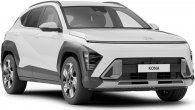Long before small SUVs reached their current epic popularity in Australia there was the Suzuki Vitara. If you believed the 1989 launch TV ads, it was the small off-roader for occasionally adventurous people prone to spontaneous drives on the beach, who still wanted a bit of luxury like power windows.
The Vitara is still here nearly 30 years later, but it’s been joined by some excellent new rivals such as Honda’s HR-V, Toyota’s C-HR, Hyundai’s Kona and Mazda’s CX-3.
So how does it stack up now? And why might it be a good idea to wait just one more year before buying a Vitara?
Suzuki Vitara 2018: RT-S
| Engine Type | Inline 4, 1.6L |
|---|---|
| Fuel Type | Unleaded Petrol |
| Fuel Efficiency | 6.0L/100km (combined) |
| Seating | 5 |
| Price From | $14,520 - $19,140 |
| Safety Rating |
|
Does it represent good value for the price? What features does it come with?
9 / 10
How much you’ll pay for a Vitara depends on which of the two grades you pick, the RT-S or S Turbo.
The most affordable Vitara, the RT-S, is front-wheel drive only and lists for $21,990 with a manual gearbox, but pay $2000 more and you can have it with an automatic. Above it, the auto-only S-Turbo is available as a front-wheel drive (FWD) for $28,990 or with all-wheel drive (AWD) (Suzuki calls it 'Allgrip') for $32,990.
.jpg)
As a model comparison there’s the Honda HR-V (which ranges in price from $24,990 to $34,340); the Toyota C-HR ($26,990 to $35,290); Hyundai’s Kona ($24,500 to $36,000) and the old favourite Mitsubishi ASX ($27,000 to $37,500).
So, the Vitara undercuts them all on price, but what about the standard features list? Is it light on? No, is the short answer.
The RT-S comes standard with a touchscreen, sat nav, reversing camera, Apple CarPlay (but no Android Auto), Bluetooth and iPod connectivity, four-speaker stereo, cruise control, shifting paddles, air-conditioning (not climate control), privacy glass in the rear, cloth seats, leather-wrapped steering wheel, 17-inch alloy wheels, roof rails and LED running lights.
The S Turbo has all the RT-S’s features but adds leather seats, proximity key and push-button start, LED headlights, alloy pedals, plus front and rear parking sensors.
That’s great value for the price Suzuki is asking for the Vitara.
Tyres fitted as standard are Continental EcoContact 5. It's a more expensive tyre but I found them to perform well with good grip and a comfortable, quiet ride.
I should point out that our AWD S-Turbo had a centre console armrest up front, while the FWD version didn’t.
Suzuki's website showcases a huge array of accessories for the Vitara including nudge bars, roof-edged rear spoilers, rims, cargo barriers, towbar kits (braked towing capacity is 1200kg for all variants) and floor mats.
Is there anything interesting about its design?
7 / 10
The Vitara’s tough and uncomplicated looks are refreshing in a segment where the styling of many small SUVs is full of softened features such as those of the HR-V, or totally left of field and busy like the C-HR or Kona.
The Vitara’s look is simple. There’s the sweep of the grille through the large headlights, there’s the flat bonnet and cleanly designed front bumper with integrated daytime running lights and fog lights.
The pumped-up wheelarches with their plastic extensions and the stepped-up contour pressed into the panels running toward the rear accentuates the car's width. And a high waistline and tall windows adds a whiff of Range Rover.
Only the rear of the car looks like it could do with more work. I can’t unsee the exhaust pipe hanging down underneath, and those taillights look half finished.
.jpg)
The front starts off so well, but the back is disappointing. Look at the images, don’t you feel it, too?
There are four colours offered, including the 'Atlantis Turquoise Pearl Metallic' our RT-S and S Turbo FWD wore and the 'Savannah Ivory Metallic' of our S-Turbo Allgrip, which my family renamed Electric Brown.
Just an FYI – that Electric Brown was so good at hiding dirt I almost didn’t need to clean it before taking the images for this review, and that was after 700km covering dirt road shenanigans, gravel running and the daily urban commuter grind.
The two-tone combinations are cool – the black roof option ($995 extra) looks great. You can also get a 'Rugged Pack' which adds a tough body kit and front skid plate.
To tell the difference between an RT-S and the S Turbo from the outside look at the wheels and grille. The top-spec car has the black wheels and chrome grille, while the base grade has the alloys and grey grille.
From the inside the top-grade S Turbo has red accents to the air vents and seat stitching.
.JPG)
About that interior – it’s a pretty cheap feeling place with the hard plastics on the dash and doors. The RT-S has cloth seats and the top-grade cars have leather seats and a small amount of suede trim to the doors, but not enough to cover the vast expanses of plastic.
There’s something you should know. In 2019 an updated Vitara will arrive and that hard plastic dashboard will be replaced by a soft-touch one. There will also be a significant safety equipment update. So, unless you need to buy a Vitara right now, maybe wait until the updated version arrives in 2019. You can read our news story on the updated Vitara here.
At almost 4.2m long, 1.8m wide and 1.6m tall the Vitara’s exterior dimensions are almost identical to the Kona – but I found the Vitara more practical and spacious. Read on to find out more.
You used to be able to get a soft top version of the Vitara, but not any more, sadly, the're all hardtops now.

How practical is the space inside?
8 / 10
All Vitaras come with roof racks as standard, but when was the last time you saw anybody use them? Nope, the true test of practicality is the space inside.
The Vitara’s boot has a 375-litre luggage capacity which is 14L more than the Kona’s cargo space. What does that mean in real world terms? It was enough for two adults and their four-year old to have a weekend away with a large overnight bag, computer bag, scooter and grocery shopping.
Fold the second row down and you have 710 litres of space which leads me to a bit of a confession – I slept in our S Turbo Allgrip overnight at a hot rod festival in the bush. It was a choice between sleeping on the ground or in the Vitara. It was below freezing and I’m a giraffe at 191cm but I slept like a baby in my Vitara tent with the seats down rugged up in my sleeping bag – see the image.
.JPG)
Under the boot floor, as well as a space saver spare wheel, there is another storage area and either side of the cargo area are plastic storage bins for muddy shoes and wet swimmers. The boot has a light and a 12-volt outlet as well.
With the rear seats up legroom in the back is great for the class. I can just sit behind my driving position without my knees touching the seat back, which I can’t do in the Kona. Headroom is excellent in that second row, too.
Cabin storage in the Vitara is great, with two cupholders up front, giant bottle holders in all doors and plenty of trays and hidey-holes to place wallets, coins and other bits and pieces. You’ll find a USB port and another 12-volt outlet in the front, too.
The only weakness is a lack of cupholders in the rear and covered storage areas in the cabin apart from the glove box. This meant having to take valuables out and put them in the boot where they were shielded by the cargo cover.
What are the key stats for the engine and transmission?
7 / 10
The Vitara RT-S is powered by a 1.6-litre four-cylinder petrol that makes 86kW/156Nm. The S-Turbo (FWD and 4WD) has a 1.4-litre four-cylinder turbo-petrol producing more grunt at 103kW/220Nm.
I don’t know you that well, but I think you should go for the turbo. I found the regular four-cylinder to be thirsty (more on that below) and a little underpowered.
The turbo engine isn’t a rocket by any means. It provides adequate power, with performance helped by the Vitara’s light weight. The AWD is the heaviest in the range, yet still only weighs 1.2 tonnes.
.JPG)
I put more than 750km on the clock of the S Turbo AWD in a week and most of it was done with my four-year old and wife on board, plus and a full boot of luggage. It wasn’t often I felt it lacked horsepower – apart from the time I was mid-three-point turn on a country road just as a low flying Commodore came over the hill, approaching at warp speed. I had to call on every kilowatt to get us moving safely.
Don’t assume 4WD means the Vitara is a capable off-roader. The system is all-wheel drive with torque distributed to wheels on demand, without the centre diff found on hardcore off-roaders. There are four modes to the Allgrip system: Auto, Sport, Snow and Lock. Hill descent control is also standard on the AWD Vitara.
The RT-S comes with a choice of five-speed manual or six-speed automatic transmission. The S Turbo is only available with the (torque converter) auto, which adds more fun to the driving experience relative to the C-HR and HR-V's CVT autos, even if the Vitara's auto uses more fuel.
How much fuel does the Vitara use? Read on.
How much fuel does it consume?
7 / 10
I test drove the RT-S, S Turbo FWD and S Turbo AWD.
Over 763km of country roads, motorways and daily city commutes the tripmeter was reporting an average of 6.8L/100km. Suzuki's claimed average consumption over a combination of urban and open roads is 6.2L/100km.
After 143km in the S Turbo FWD I recorded a higher 10.9L/100km average, but that included fewer motorway kays and more inner city driving. The official combined mileage is 5.9L/100km.
The RT-S recorded the highest fuel consumption, not helped by the fact most of my driving was on suburban roads, the trip computer recording an average of 14.3L/100km. On top of that, my desire for more oomph led me to constantly feed it more fuel in the hope it might move faster.
.JPG)
Warranty & Safety Rating
What safety equipment is fitted? What safety rating?
6 / 10
The current Vitara has the maximum five-star ANCAP rating, but that score was awarded in 2015 before features such as AEB were a prerequisite for top marks.
That leaves the current Vitara missing advanced safety tech which is available on competitors such as the Kona, C-HR and H-RV. A 2019 update will resolve the issue by adding a full suite of advanced safety equipment, including AEB.
When it comes to new cars, safety should be a priority for any buyer, and if it was my money I’d hold off on a Vitara purchase until that updated car arrives in 2019.
But don’t get me wrong, the Vitara is not unsafe. There’s still ABS, traction and stability control (ESP) and seven airbags.
For child seats there are two ISOFIX points and three top tether anchors across the second row.
Where is the Vitara built? Japan? No. Korea? Nope. Thailand? Not even close. The Vitara is built in Hungary.
What does it cost to own? What warranty is offered?
7 / 10
The Vitara is covered by Suzuki’s three-year/unlimited kilometre warranty. Servicing is capped for five years but Suzuki recommends six month/10,000km intervals between them. Most carmakers only ask that you service the vehicle annually.
Services are capped for five years at $175 each for the first three visits, then $359, $175, $379, $175, $399, then $175 for the last two in that period.
What's it like to drive?
8 / 10
Here’s the short version for people not interested in technical stuff: the Vitara is great fun and easy to drive. And that goes for the RT-S and the S Turbo.
The reason the Vitara is easy to drive can be broken down into: i) great visibility through those large windows and over the flat bonnet, ii) the driving position which is fairly high, and iii) the small size of the car which makes it easy to park and pilot through city streets.
It’s fun to drive because: i) the steering is accurate and returns an in-touch feeling with the road; ii) the ride is comfortable with good body control and decent handling for the class, and iii) that six-speed auto is so much more engaging than a CVT.
.JPG)
The choice for me is the AWD S-Turbo. I had a hoot driving it on the same roads that I normally test sports cars on and while it’s no performance car, I was grinning the entire time.
I didn’t test the AWD’s off-road capability more than taking it down onto the beach and for a bit of dirt road driving. I wouldn’t recommend venturing into much tougher terrain than that in the Vitara. If you do want to go further afield, and want to do it in a Suzuki, the new Jimny will be more adept.
Do you need to spend the extra $4k to have an all-wheel drive Vitara? Nope, you don't need to. But if it was my money, I'd fork out the extra for the added traction AWD brings in the wet.
Here's a real-world example. The FWD S Turbo spun its front wheels trying to climb the steep incline on my test route. The surface (bitumen) and conditions were dry. On the same hill, under the same conditions, the AWD didn't lose traction at all.
Verdict
The Vitara is fun and easy to drive, plus it’s good value and practical. But if the lack of advanced safety equipment is a deal breaker for you, hang on until 2019 when the updated Vitara arrives. That said, you can pretty much guarantee Suzuki will drop the price when this current Vitara goes into run-out mode, and you could get a damned good deal.
The sweet spot in the range is the S Turbo FWD - it lists for less than $29K and has all the features of the AWD including that great 1.4-litre turbo-petrol engine.
Is the Vitara the original and best small, affordable SUV? Tell us what you think in the comments below.
Pricing Guides





.JPG)
.JPG)
.JPG)
.JPG)
.JPG)
.JPG)
.jpg)









.png)








_1.jpg)



.jpg)




.jpg)

.jpg)
Comments